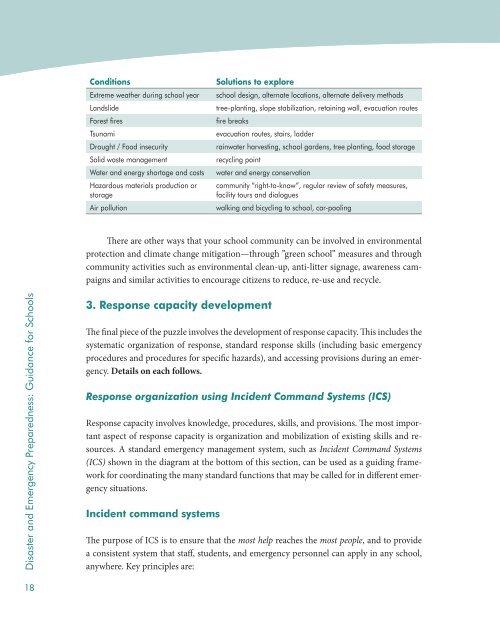Disaster and Emergency Preparedness: Guidance for ... - INEE Toolkit
Disaster and Emergency Preparedness: Guidance for ... - INEE Toolkit
Disaster and Emergency Preparedness: Guidance for ... - INEE Toolkit
You also want an ePaper? Increase the reach of your titles
YUMPU automatically turns print PDFs into web optimized ePapers that Google loves.
ConditionsExtreme weather during school yearL<strong>and</strong>slideForest firesTsunamiDrought / Food insecuritySolid waste managementWater <strong>and</strong> energy shortage <strong>and</strong> costsHazardous materials production orstorageAir pollutionSolutions to exploreschool design, alternate locations, alternate delivery methodstree-planting, slope stabilization, retaining wall, evacuation routesfire breaksevacuation routes, stairs, ladderrainwater harvesting, school gardens, tree planting, food storagerecycling pointwater <strong>and</strong> energy conservationcommunity “right-to-know”, regular review of safety measures,facility tours <strong>and</strong> dialogueswalking <strong>and</strong> bicycling to school, car-poolingThere are other ways that your school community can be involved in environmentalprotection <strong>and</strong> climate change mitigation—through ”green school” measures <strong>and</strong> throughcommunity activities such as environmental clean-up, anti-litter signage, awareness campaigns<strong>and</strong> similar activities to encourage citizens to reduce, re-use <strong>and</strong> recycle.<strong>Disaster</strong> <strong>and</strong> <strong>Emergency</strong> <strong>Preparedness</strong>: <strong>Guidance</strong> <strong>for</strong> Schools3. Response capacity developmentThe final piece of the puzzle involves the development of response capacity. This includes thesystematic organization of response, st<strong>and</strong>ard response skills (including basic emergencyprocedures <strong>and</strong> procedures <strong>for</strong> specific hazards), <strong>and</strong> accessing provisions during an emergency.Details on each follows.Response organization using Incident Comm<strong>and</strong> Systems (ICS)Response capacity involves knowledge, procedures, skills, <strong>and</strong> provisions. The most importantaspect of response capacity is organization <strong>and</strong> mobilization of existing skills <strong>and</strong> resources.A st<strong>and</strong>ard emergency management system, such as Incident Comm<strong>and</strong> Systems(ICS) shown in the diagram at the bottom of this section, can be used as a guiding framework<strong>for</strong> coordinating the many st<strong>and</strong>ard functions that may be called <strong>for</strong> in different emergencysituations.Incident comm<strong>and</strong> systemsThe purpose of ICS is to ensure that the most help reaches the most people, <strong>and</strong> to providea consistent system that staff, students, <strong>and</strong> emergency personnel can apply in any school,anywhere. Key principles are:18
















